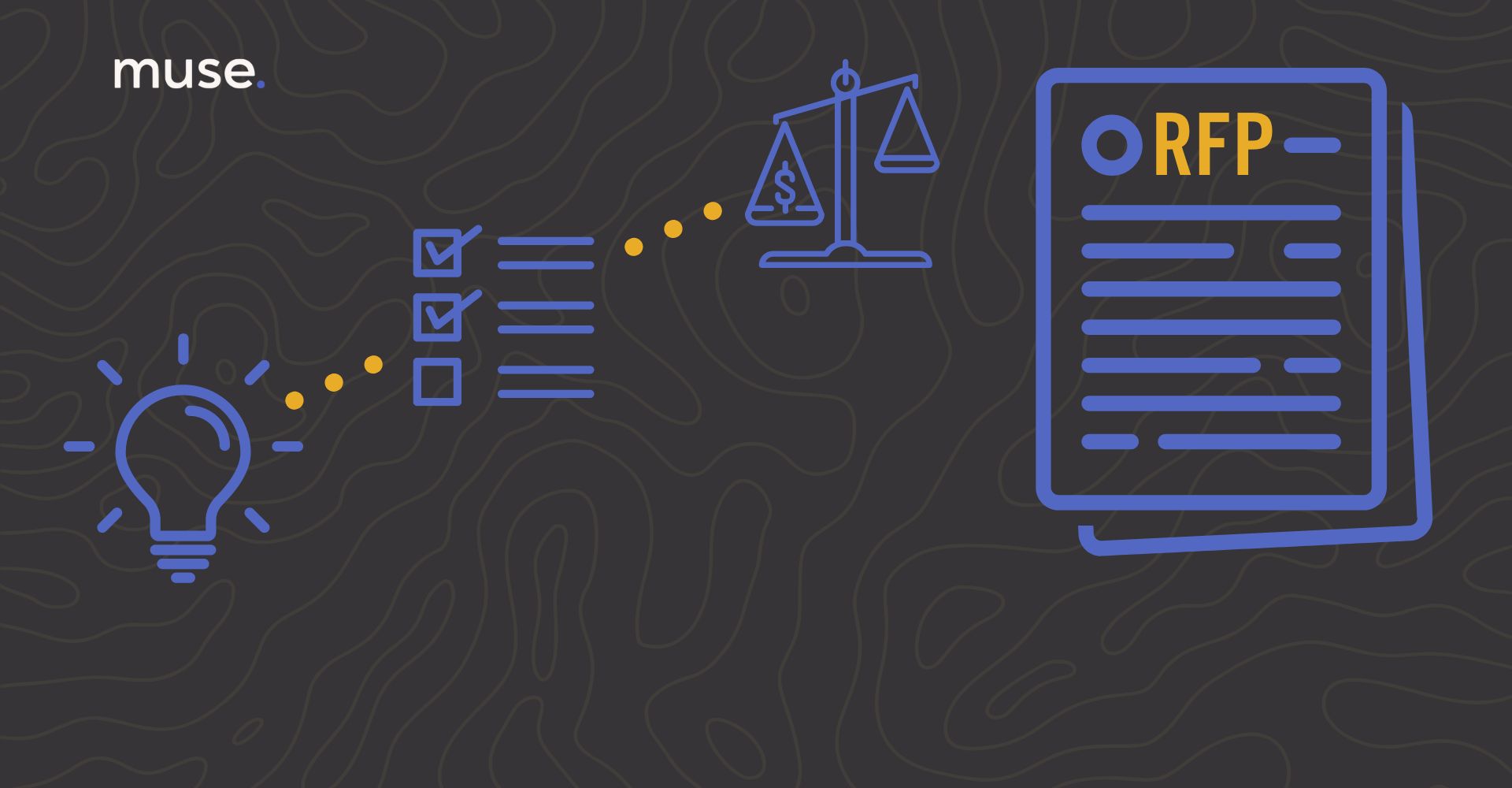How to Write an RFP for a Non-Profit Rebrand
Our step-by-step guide for how to write an RFP streamlines the complex. Apply these insights to your next project request.
Start by arming yourself with a smart checklist.
As an agency specializing in brand strategy for membership organizations, we’ve received one too many rebrand RFPs that left us scratching our heads. What exactly is this organization asking for? Does the proposed project list align with the stated goal? What’s driving this timeline? Like a party invitation, your RFP sets the tone for the engagement. If your request is clear and concise, you’ll receive more accurate, high-quality proposals for consideration. It’s that simple.
Quick links to guide you through this article:
- Define the reason for the rebrand
- Common RFP phases and deliverables
- The case against "spec creative"
- Process overview questions to ask
- Budget transparency
- Outline your vetting process
- Final tips & RFP checklist
Before agencies invest dozens of hours in a customized and competitive proposal, we must feel confident we’re the right fit for the project. A well-crafted RFP will draw a more qualified pool of responses, including agencies like ours that are more selective about whom they choose to do business with. Skill fit is the priority, of course. Branding projects, in particular, also require a personality fit because your agency team will become deeply immersed in your organization. You’ll want to ensure trust, respect, and commitment to the common goal from the first moment of connection.
Here are the most essential inclusions to get accurate quotes and draw right-fit responses.
Define the reason for the rebrand.
Whether your organization underwent a dramatic strategic change or you feel that your logo is dated and needs a refresh, there’s a reason you’re making this investment. Make it known. This gives agencies context for the history and complexity of the challenge. The more drastic the updates, the more costly the project can be. For example, a merger of two organizations must include a cultural assessment of each membership base. This type of brand strategy engagement can be time-consuming to ensure that the appropriate voices are heard and adapted within the new brand structure. This process differs from a modern update to an existing visual identity, which would also require a cultural and values assessment, but as with any aesthetic revision, the process is generally more topical.
List the projects you want, but be open to ideas about your needs.
Be clear about your project list. A proper agency response will cover pricing and approach for those items, demonstrating that the agency heard you. The agency response may also include quotes for projects you have not considered. You may believe that you need a new logo, but that change would have a ripple effect on everything from your stationary to your building signage. Are these changes allocated in your budget and included in the RFP? You may choose to split your RFP into two or three phases, each with its own set of deliverables.
Projects common to a core rebrand engagement:
- Name change
- Visual identity: Logo, color palette, typefaces, etc.
- Brand architecture
- Brand position & narrative
- Mission, vision, values
Projects common to brand rollout:
- Rollout plan: Stakeholders, membership, media, public
- Staff training
- Membership presentations
- Launch announcements and launch campaign materials
Projects common to rebrand activation*:
- Website
- Placemaking/wayfinding signage
- Brand campaign concept and materials
- Templates for key materials (social, newsletter, etc.)
*An important note: A qualified brand agency can provide a generalized brand activation plan through the pitch process but may only commit to pricing for a complete roll-out once they learn more about your organization during the core rebrand engagement.
Be sure to list the project deliverables rather than the process steps. For example, one common mishap is to include “discovery” as a project. This can be confusing, and you may not receive apples-to-apples price comparisons. While a discovery stage is common to all agency processes, each agency will likely take a different approach. Because a discovery stage is a prerequisite for an effective outcome, it’s typically not estimated separately as a project.
Ask for project samples and case studies, not free creative ideas.
In the past, many organizations would ask agencies to present unpaid creative ideas and concepts (or “spec creative”) as part of the pitch process. These requests, though still common among corporate agency pitches when millions of dollars are at stake, have become faux pas. First, agencies protect their intellectual property; many have policies against doing spec creative. Second, the creative presented wouldn’t have been informed by anything other than external research and would likely be way off the mark. If you need to “try before you buy” to feel confident in your agency decision, consider a small paid engagement with your finalist agencies.
Instead, request relevant portfolio samples, especially before/after spotlights. Look for project outcomes similar to what you have in mind. Remember that brand strategy is more than meets the eye. If you have communication or identity challenges brought on by changes to your strategic plan, you’ll need more than pretty pictures to shepherd your organization into the future. Be sure to ask for written case studies demonstrating strategic, writing, and business acumen, which can be much more challenging to identify and vet than great creative talent.
Request a detailed process overview.
When you hire a brand agency, you’re not only buying stellar creative output; you’re also purchasing the journey to that destination. You have many voices to navigate along the way - your board, your membership, your various committees. You want to know that your agency will be strategic about who to include at what point in the process. Your agency leadership should have the experience and perspective to guide your team toward informed decisions. Analysis paralysis is real, especially with many mixed (and subjective!) opinions, and this stalled momentum can be costly. Your agency team should include a skilled facilitator to gain buy-in and maintain progress.
Once you bring an agency to an interview, be sure to ask pointed questions about specific portfolio pieces that provide insight into the nuances of their process. The more detailed and confident their responses, the more experienced they’re likely to be. Here are a few frequent questions we’ve fielded from smart non-profit committees:
- How long did this process take?
- Who was involved in contributing to the process on the client side?
- When are Board contributions included?
- What are the key approval benchmarks?
- What constitutes an incremental cost throughout the process?
- Who facilitates meetings?
Budget transparency is optional but preferred.
Without an established budget in the RFP, you’ll likely be surprised at the range of pricing options you’ll receive—agencies base branding service pricing on many different variables. Most commonly, the differential is related to your organization’s size. There’s much more at stake when your brand is as visible as the United Way compared to a smaller community-based non-profit. The higher the exposure, the higher the price. The agency’s size will also affect pricing. Like attorneys, the bigger the bench, the bigger your bill. Finally, agencies specializing in branding and your industry may be more expensive than generalist agencies. Just like you would pay a more experienced and senior employee a higher salary, you can expect a similar approach to pricing agencies.
A stated budget range will allow an agency to qualify itself for your engagement. If pricing seems low, an agency has a choice: walk away from the opportunity or reduce the depth of scope to accommodate the budget. Most agencies don’t have hard and fast rules about this unless the budget is way out of range. Agency leaders often choose to flex pricing if the engagement:
- Has exceptional portfolio potential
- Is the first project in a long-term engagement
- Will occur during a slow period when the agency has extra capacity
If you choose to list a budget, make sure you’re well-informed with research on fair market pricing. You can also ask experienced consultants and industry professionals.
Marketing, especially brand strategy, is an industry where you generally get what you pay for. If you’re on the fence about moving an agency to the final round, don’t write off the most expensive proposal until you give the agency a chance to validate its costs. In the short term, it may save you money to go with a cheaper option, but you might be surprised at the hidden value that more established agencies can offer you through a proven process, tenured creative talent, and specialized expertise.
Outline your vetting process.
Agencies want to know the process and timing for your decisions. Some will opt out if the timing is too ambitious or they’re not accepting new clients during your timeframe. This saves both parties time and effort. Be sure to list your qualifications and, if developed, your rating system. If your industry is so complicated that you require an agency team with industry experience, clearly state this requirement. You still may receive responses from generalist agencies who are confident they can quickly climb the learning curve. It’s up to you if you want to invest time and effort in a more extensive onboarding phase.
Most agencies will want to pitch in person during the final round. Knowing if you’re open to an in-person presentation and who will be involved in the final qualifying stage is helpful. The exception is global organizations, which typically prefer virtual meetings for convenience. Even so, we’ve flown to a few global board meetings to pitch or present because brand strategy requires high-level strategic decisions and discussions that will significantly shape an organization’s future.
Please avoid stating feel-good inclusivity and equity language if you can’t demonstrate it through a diverse board and vendor selection protocol. Equity is table stakes, anyway. Every agency, regardless of whether it’s minority- or woman-owned, deserves a shot at the business as long as it meets and exceeds your qualifying expectations. On the flip side, as a certified female-owned business, we don’t expect special consideration and have never been awarded business because of this designation. It’s our job to prove to your leaders that we can do the job well. It’s your job to select the best agency, regardless of whether one of your board members strongly prefers his golf buddy’s agency.
List proposed engagement timing, especially important events.
A brand process is almost always flexible unless there’s a hard launch date, like an annual membership event, where you intend to make a splash with the launch. You don’t need to be specific about each project’s due date. Include your proposed launch date; the agencies will typically define their process benchmarks to accommodate. Be realistic about your preferred timing. (Note: This article will give you a sense of how long a brand refresh can take.)
Final Tips for how to write an RFP
- Be responsive: Remember, the agency is vetting you as well. A lack of response during the RFP process signals a lack of commitment to the project, which is a warning sign for agencies.
- Maintain momentum: Try to avoid analysis paralysis. Keep your decision committee accountable for reviews and decisions.
- Clarify questionable responses: If you feel good about an agency but need more information, don’t hesitate to ask for specifics.
- Respect agency time. Remember, agencies are juggling their paid clients alongside sales opportunities like yours. Consider whether the hoops you’re asking them to jump through are essential to your decision-making process.
RFP Checklist
Introduction: A paragraph or two about your organization
- What do you do?
- Whom do you serve?
- When and why were you established?
Background: Reason for the rebrand
- Why are you rebranding?
People: Information about decision structure
- Who will be involved in brand decisions?
- How many layers of approvals are required?
Project Request: Clear list of projects to be priced within this engagement
- Core Rebrand Projects
- Brand Rollout Strategies
- Brand Activation Projects
Vetting & Project Timing: Benchmark dates for hiring the agency and launching the brand
- What are the stages of consideration?
- When is the deadline to make the final decision?
- What is your preferred launch date?
- Is this date event-driven or flexible?
Budget: Optional range for estimating purposes
- What is your budget for the entire project?
- Is this the starter budget for a continued relationship?
Portfolio Samples: Visual snapshots and strategic case studies
- Logo Before/After
- Strategic Case Studies: Challenge/Insight/Solution
Brand Activations: Websites, tradeshow booths, campaigns
Vetting Process:
- What are the stages of consideration?
- When is the deadline to make the final decision?
Would you like to include Muse in your rebrand RFP? We’d love to be considered! Send your request to Hello@MuseHeadquarters.com.
About the Author
Jackie Bebenroth is Founder and Chief Brand Advisor of Muse. She works alongside leading brands and executives to develop strategic positioning and messaging strategies that set the stage for long-term success. Her work, from local restaurant branding to six-figure global initiatives, has flown her around the country to speak on the art of content marketing. Jackie has earned a number of accolades, most notably a SXSW Interactive finalist award, the American Advertising Federation’s 40 under 40 award and Content Marketing Institute’s Content Marketing Leader of the Year.
More Good Reads

Q&A: Navigating AI Overviews, Site Traffic Drops & the New Frontier of Search
Lauren Konst interviewed Matt Burkarth, a digital marketing expert from WTM Digital, for actionable tips on surviving and thriving in the AI-driven content landscape.

Modern Wellness Customer Personas: 2025
How to target different wellness motivations of consumers, updated for 2025.

